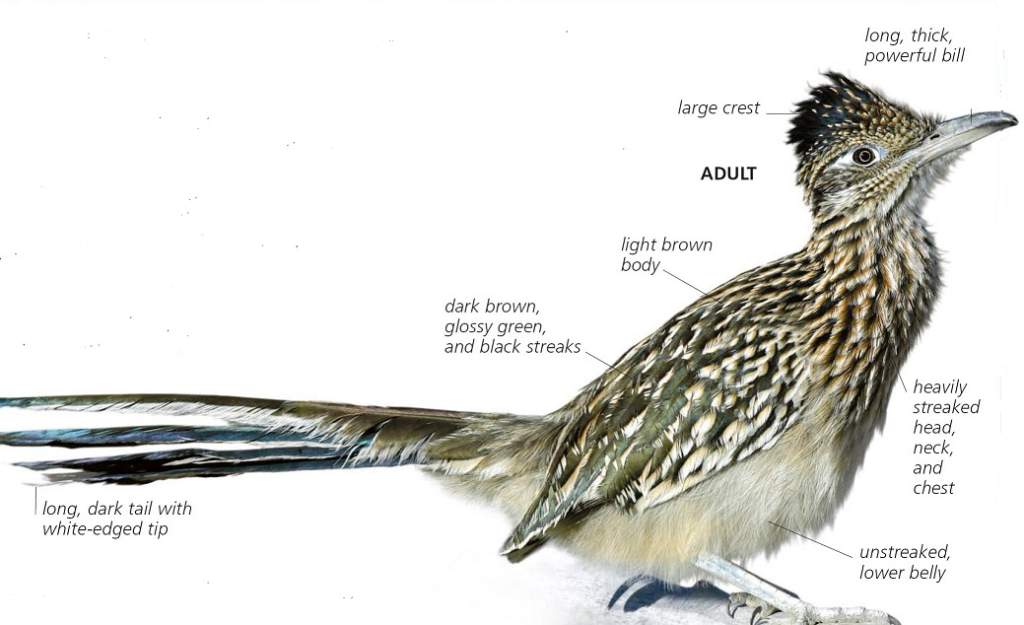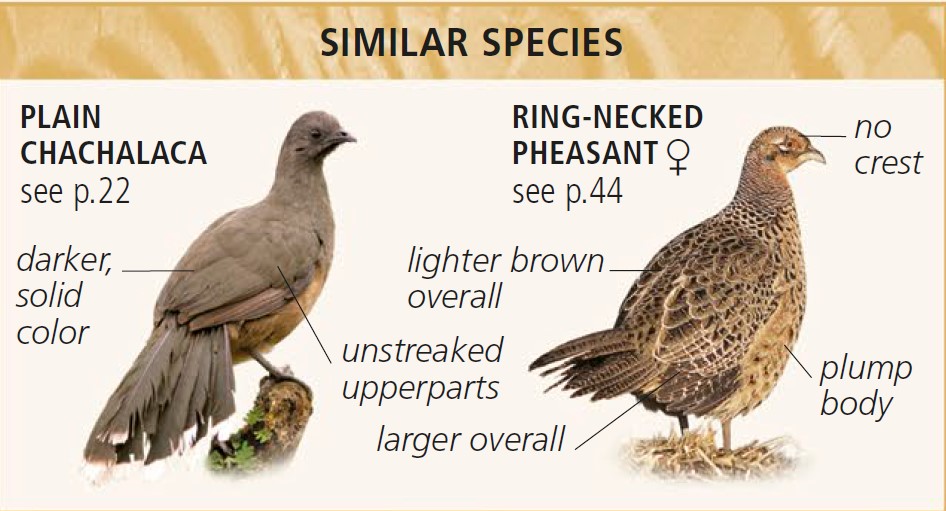Family: Greater roadrunner (Geococcyx californianus) is a member of the cuckoo family Cuculidae
Behavior: Unlike the other species of North American cuckoo, the Greater Roadrunner is a ground bird, but it can fly, despite preferring to run. Most of the upper body is brown, with occasional pink patches and black streaks. Roadrunners have four toes on each zygodactyl foot, two facing forward and two facing backward. Their toes are brown with faint gold dots.
Diet: Eats a wide variety of insects and small reptiles such as lizards, birds, and mammals; also eggs and carrion. Its speed enables it to overcome and chase prey on foot, especially lizards and small birds. Its generalized feeding habits allow this bird to take advantage of whatever food resources it comes across. This may be one of the main reasons roadrunners are expanding their range.

Flight: Greater roadrunner flight is weak flutter to high perches; open wing glide from elevated perch. With its long legs, the bird prefers to run. It travels short distances of 4 to 5 meters between prospective roosts.
Distribution: Greater roadrunner is widespread across the southwestern United States, from California to Louisiana and north to Utah, Colorado, Kansas, and Arkansas.
Habitat: It lives at low elevations in open brushy areas mixed with thorn scrub such as mesquite, as well as pinyon-juniper shrubbery, deserts, and chaparral.
Movement: The bird is resident.
Size: The greater roadrunner measures 21 inches (53cm) in length, along with a Wingspan of 23 inches (58cm) and Weight of 11 ounces (300g)
Height: It is the largest cuckoo in the Americas, at around 25–30 cm tall.
Social: Solitary/Pairs
Meaning: “Californian earth-cuckoo” is the meaning of the scientific name.
Lifespan: The average lifespan is Up to 6 years
Other Names: It is also known as snake killer, chaparral cock, and ground cuckoo.
Elevation: It is unusual to find the larger roadrunner over 9,800 feet; however, it can be found between 200 and 7,500 feet below sea level.
Vocalizations: The greater roadrunner call is a cooing coo-coo-coo-cooo-cooooo series of 4–5 descending notes. Male and female roadrunners vocalize most frequently during the incubation period and the raising of the chicks. After that, there is a series of five or six sounds, together with groans, that may be heard from 700 feet away.

Nest: The nesting is a shallow, loosely organized cup of twigs and branches, lined with grass, animal hair, and feathers. Nest construction starts in March; the female builds the nest while the male gathers materials. The nests are low, compact platforms made of thorny branches lined with fine materials like feathers, grasses, snakeskin, roots, and other materials. They are typically erected in bushes or cacti.
Eggs: The bird lays 3–5 eggs and 2 broods a year, April–September.
Fossils: Greater roadrunner fossils have been discovered in both Mexico and the United States; the oldest known fossil is thought to be from a cave and is estimated to be 33,500 years old. Other known fossils include those from Santa Barbara and Kern counties, as well as those from Northern Mexico.
Superstitions in culture: In Mexico, some said roadrunners carried infants, just as the white stork was supposed to in Europe; other Anglo frontier people thought roadrunners directed lost people to trails; and some Pueblo Native American groups, including the Hopi, believed they offered protection against evil spirits.
Greater Roadrunner vs. Lesser Roadrunner: Both species have long tail feathers that help with balance; the lesser roadrunner is significantly smaller and has a lighter tan coloring, while the bigger of the two, the greater roadrunner, is about two feet long with black, brown, and white speckled feathers and a shaggy crest.
State Bird: The greater roadrunner is the state bird of New Mexico.
Speed: The greater roadrunner can travel at a speed of 20 to 25mph (32 km/h) over extended distances. It prefers to run in open spaces such as roadways, packed pathways, and dry riverbeds over dense vegetation.
Drinking: Grater Roadrunners obtain much of their moisture from their food but will take full advantage of water whenever it’s available.
Lofty Adobe: This species nests off the ground and can occasionally be seen occupying elevated perches.
Status: Least Concern
Species: Geococcyx californianus
Order: Cuculiformes
Read More: 10 Cool Facts of Eastern Bluebird







